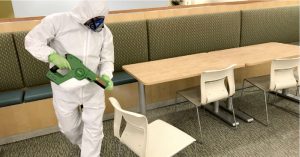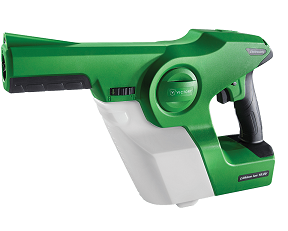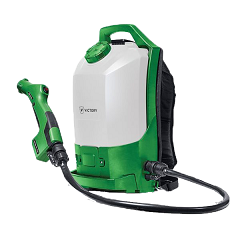For anyone looking for coronavirus cleaning services, without a doubt the most intrigue and curiosity orbits around a singular piece of equipment that’s become ubiquitous with killing COVID-19 : An electrostatic sprayer.
These sprayers, if you’re unfamiliar, are battery-powered “guns” used to apply a liquid disinfectant. The sprayer creates an electrostatic mist, which means the disinfectant “sticks” to any surface it touches and will work its way into small cracks and crevices.

The reason for the surge in electrostatic sprayers’ popularity is simple: They’re an efficient, fast and effective way to ensure every surface in an office, school, clinic, or any facility, is blanketed in commercial-grade disinfectant capable of destroying an array of bacteria and viruses.
But with that interest comes a lot of questions. Most people didn’t regularly use electrostatic sprayers for frequent disinfecting until the pandemic hit. For that reason, KleenMark experts are going to break down the best options, when to use an electrostatic sprayer, and provide a few helpful tips to get you started.
When to spray
This is pretty straightforward. A 360-degree cleaning and disinfecting program should include a regularly scheduled cadence of deep disinfection.

“The only way to make sure a disinfectant is applied to every inch of your facility is to use an electrostatic sprayer,” said Mike Staver, KleenMark’s director of operations. “When combined with specially trained staff, this is the single-best way to disinfect an office.”
Confirmed COVID-19 case – If someone who tested positive for COVID-19 was in your facility, a deep disinfection is recommended – and often required.
Prior to reopening – Even if only a few people have been in your facility since the pandemic hit, it only takes one person to spread germs. Additionally, your employees and visitors want to know you’re taking proactive steps, which includes deep cleaning and disinfecting.
Regularly scheduled deep cleaning – While daily cleaning and disinfecting of high-touchpoint surfaces such as door handles is the foundation good coronavirus cleaning services, regular deep disinfection is now expected among staff – and it’s required in some industries. This can include many things, but almost always starts with using an electrostatic sprayer to make sure each all surfaces are properly treated.
Large areas with high turnover – From churches needing to disinfect between services to schools that need to cover thousands of square feet after each school day, electrostatic sprayers are the most efficient and cost-effective option.
Multi–purpose/open layouts – Spraying is beneficial in spaces such as yoga studios, locker rooms and break areas, where a lot of different people use the same space over the course of a day. Open floor layouts, where there is little separation of workers and visitors, also is ideal for regular disinfection using a sprayer.
Which sprayer is right for you?
Several options exist on the market, but Staver prefers Victory electrostatic sprayers due to their proven track record, quality and longevity.

Handheld sprayer
Make + model: VP200ESK
Best use: Small facilities, such as gyms and restaurants
Style: 16.8V lithium ion-powered handheld sprayer
Weight: 3.8 pounds
Capacity: Removable tank holds 33.8 ounces.

Backpack sprayer
Make + model: VP300ESK
Best use: Large buildings, such as schools, clinics and multi-tenant offices
Style: 16.8V lithium ion-powered backpack sprayer
Weight: 10 pounds
Capacity: Removable tank holds 2.25 gallons.
Industry pro tips
Once you’ve decided to incorporate electrostatic sprayers into your disinfectant program, it’s time to get down to business.
Read the Disinfectant Labels – Understanding the information on a disinfectant product label is essential for effectively killing germs. It also provides information to keep you safe when using the product.
Clean before you disinfect – It’s important every surface you spray is first cleaned. If you don’t remove dust, dirt and grime, the disinfectant will not reach the surface. Instead, the disinfectant will “cling” to the dirt, rather than killing germs on the surface.
Wear personal protective equipment (PPE) – The use of sprayers with commercial-grade disinfectants require proper personal protection equipment (PPE), including a Tyvek suit, mask , goggles and gloves.
Understand the chemicals you use – From dwell times to which bacteria and viruses each disinfectant will kill, it’s vital to know how your chosen chemical works. Check out this article to learn more about the ins and outs of disinfecting.
Clean your sprayer – It may sound redundant but after each use, run water through your sprayer to keep it from getting clogged and performing like new.
Pick the right battery – Four-hour and two-hour batteries are available. Also, always place each battery back on the charger when done to maximize battery life.
Get the training – How to apply disinfectants using an electrostatic sprayer – and how to do it in a way that ensures you’re taking proper steps to kill COVID-19 – requires varying levels of training and expertise. If you’re uncertain, commercial coronavirus cleaning services such as KleenMark can help.

“At KleenMark, we have more than 100 disinfecting technicians who have received specialized training from a third-party organization that has expertise in disinfection techniques approved by the CDC,” Staver said. “If there is any doubt, it’s always worth at least talking to a company that understands the intricacies of proper deep disinfection practices.”
Need more information, have questions or want to place an order? Contact our product expert, Doug Lerch at dlerch@kleenmark.com or visit kleenmarkdistribution.com.
